Little Things Matter
By Meredith Swett Walker ’99 for Bowdoin MagazineIN DR. ALEX WILD’S PHOTO of the Australian ants Rhytidoponera victoriae and Amblyopone ferruginea, the dark brown Rhytidoponera seizes the lighter Amblyopone, twisting her to the ground. The camera angle puts the viewer on the ant’s level, and the motion and drama of the struggle is palpable.
The image is reminiscent of George Bellow’s famous painting “Stag at Sharkey’s,” in which two boxers grapple in the ring. For the ants, however, the stakes are much higher than a boxing title.
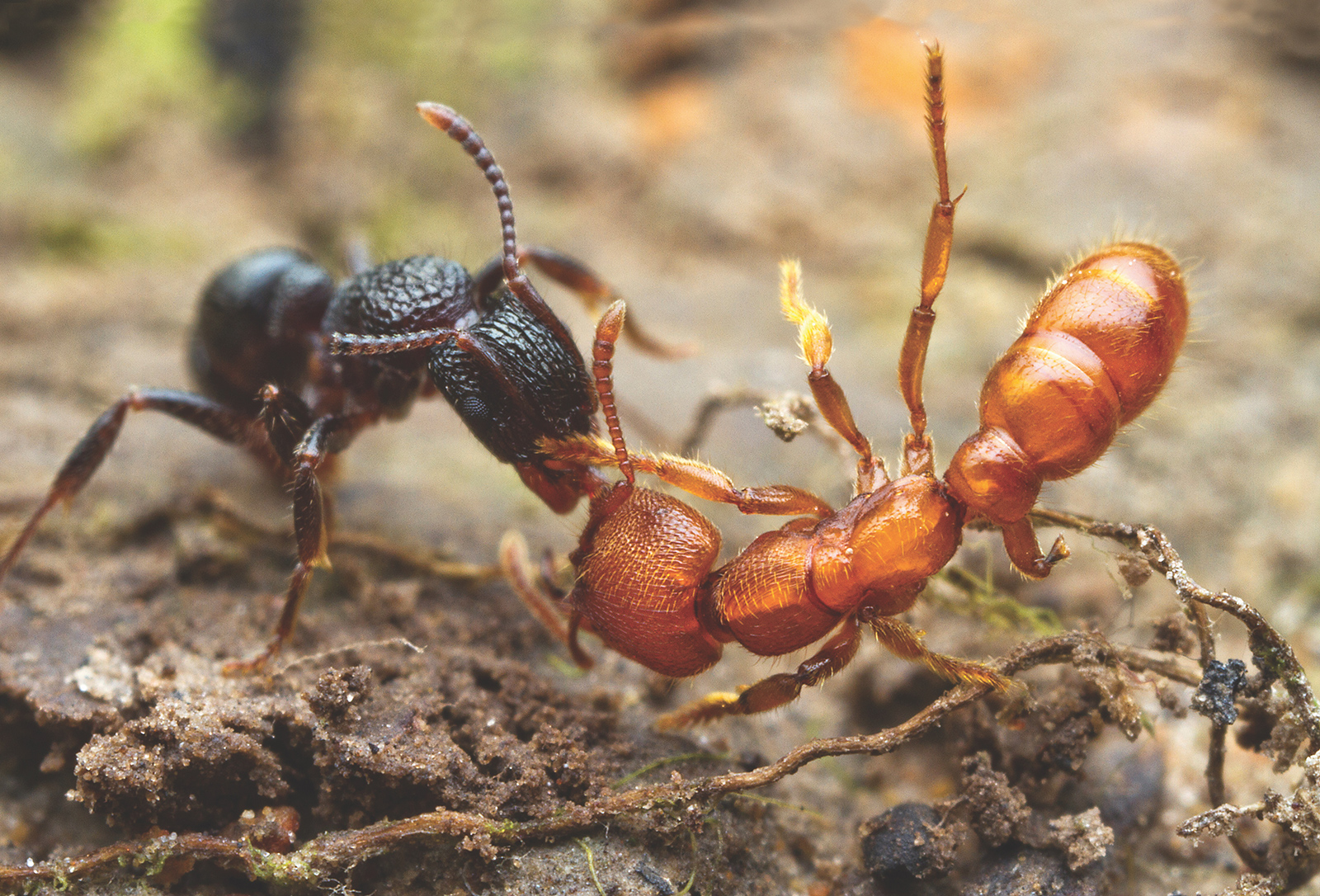
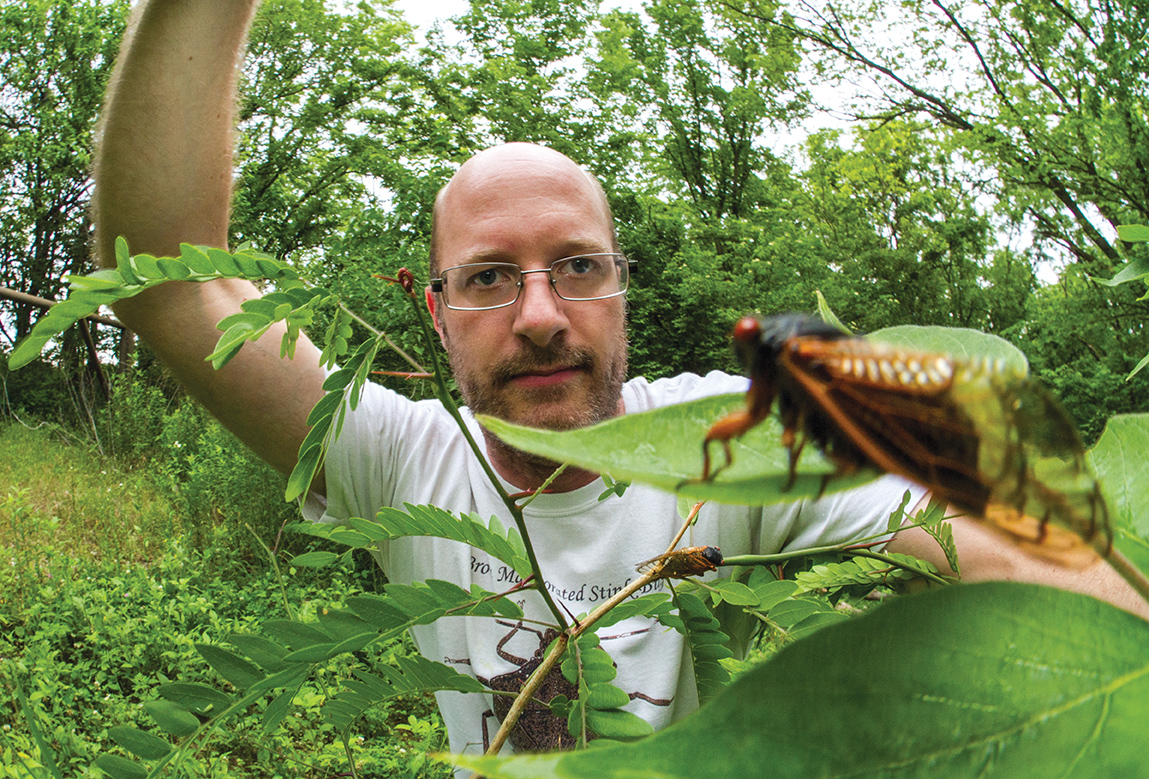
Capturing these images requires knowledge of insect behavior as well as a willingness to physically put himself on the insect’s level—be that on a rainforest floor, or in a patch of poison ivy. (A nasty rash was the price paid for a photo of an epic battle between two colonies of ants.)
When asked what he hopes viewers take away from his insect photos, Wild says, “I would like them to see the subjects as individuals. I try to picture the subject in some sort of relatable position or pose.” Even when photographing a group of insects—say, a mass of bees on a honeycomb—he tries to keep the individual in mind. “There’s always at least one individual somewhere in the picture that looks like it’s the subject,” he says. “There’s an emotional point of entry.”
Wild’s own entry into the world of insects happened early. Growing up in Upstate New York, he enjoyed looking for creatures outdoors. “Ants were an early interest. I have this memory of me at age five, trying to stuff carpenter ants into a Styrofoam cup,” says Wild. The ant bites did not dim his interest in science, but middle-school science classes did. “What I learned in science class has such a tenuous relationship to what you see when you’re a naturalist outside,” he says. Wild had a wide variety of other interests, such as music and literature, to focus on in lieu of science.
It wasn’t until he arrived at Bowdoin that his interest in insects was rekindled. Wild says that during his early years at the College he was best described as an “introductory studies major,” taking a wide variety of courses in the liberal arts tradition. But his choice to take a course in ecology, taught by Professor Nat Wheelwright, proved fateful. “He pulled me aside at one point and said, ‘I noticed you really seem to like ants,’” says Wild. “He said, ‘You know, you could do an undergraduate thesis on them.’ Nat sort of opened my eyes to the fact that you could actually do nature and insect things as a career path.”
Wild did indeed do an honors thesis on ants. He spent a summer at the Bowdoin Scientific Station on Kent Island, in the Bay of Fundy, collecting the archipelago’s ants, then painstakingly identified the fourteen species that occurred there. Identifying ants isn’t as simple as looking them up in a field guide. There are an estimated 22,000 species of ants in the world—only about half of which have been classified or formally described as species. To identify specimens, you need to use detailed identification keys and compare them to previously identified ants in a scientific collection. So Wild visited Harvard’s Museum of Comparative Zoology, home to one of the best collections of ants in the world, and worked with curator and ant expert Stefan Cover to identify the Bowdoin Scientific Station ants. This introduction to the world of entomology collections must have been auspicious—two decades later, Wild would become a curator himself.
But Wild’s career path would take some unusual turns, in part thanks to another Bowdoin professor—Ed Gilfillan of the Environmental Studies Program. During his junior year, Wild studied abroad in Ecuador in a semester program run by Gilfillan. “That was my first real trip overseas,” says Wild. “I had no idea what other countries were like.” After Bowdoin, Wild spent three years with the Peace Corps in Paraguay, teaching beekeeping and working with an agricultural extension office.
His experience in Paraguay left him unafraid of straying from the established track. Wild earned a PhD from the University of California, Davis, where he studied the taxonomy of the invasive Argentine ant and later held postdoctoral positions at the University of Arizona and the University of Illinois. But he wasn’t wedded to the idea of a traditional academic career.
“I was always a naturalist. And being a naturalist is sort of something that comes and goes with academia. There are parts of academia that are compatible with it and parts of it that are totally orthogonal to it,” says Wild. “Also knowing that I was surviving and quite happy on $200 a month in rural Paraguay sort of took the pressure off, you know.”
While in graduate school, Wild had taken up insect photography as an aesthetic complement to his scientific work, a hobby that would accidentally become a business. “The internet was still very young. And if you wanted to share your photos online, you couldn’t just upload them to Facebook, or Instagram, or even Flickr, because none of those things existed at the time,” he explains. “You had to build your own website, and that’s what I did."
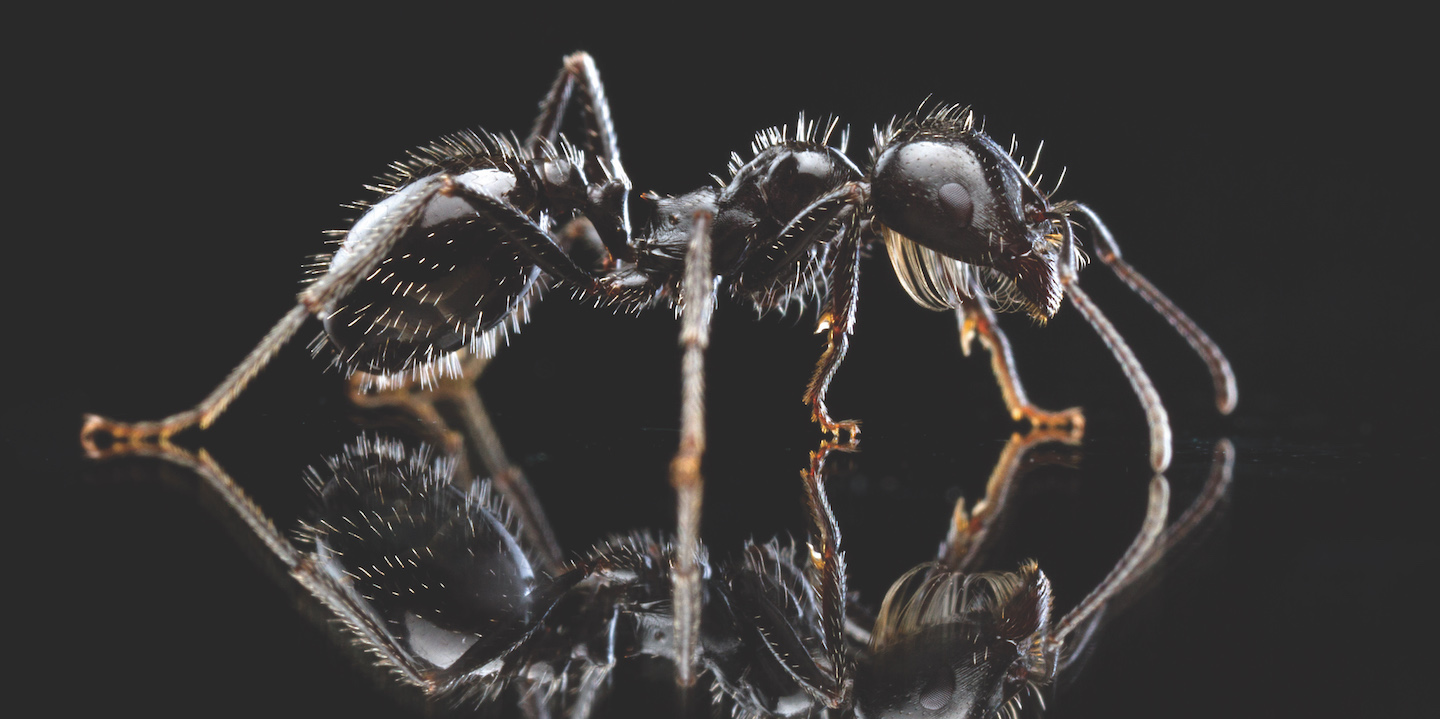
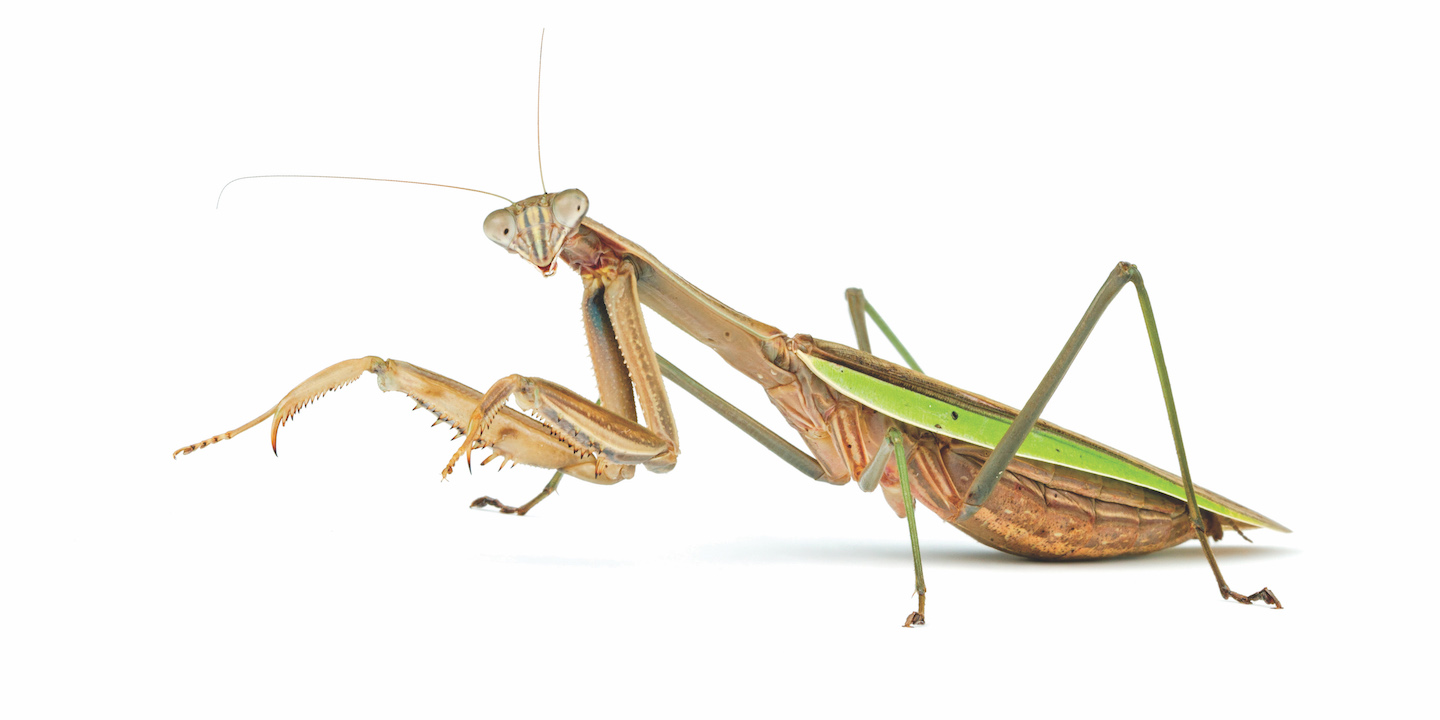
Wild’s scientific expertise was essential to his success in the photography business. “I was doing a thesis on taxonomy. And it meant that, as I was experimenting with my early photography (and being generally not very good at it), I was able to put a Latin name on every species and make a little caption about the behavior. And then I just posted it on this website I made,” he says. These species identifications and natural history notes made the photos more useful for photo editors. “I didn’t appreciate it at the time, but I had de facto established a photography business by staking out a corner of the web.” Soon photo editors found his work and began asking him about licensing his images for textbooks and magazines. A business was born.
Wild spent several years as a freelance insect and nature photographer, selling his stunning images of insects and teaching insect photography workshops around the globe. It was rewarding, and he was happy being his own boss, but in 2014 the University of Texas started calling and kept calling.
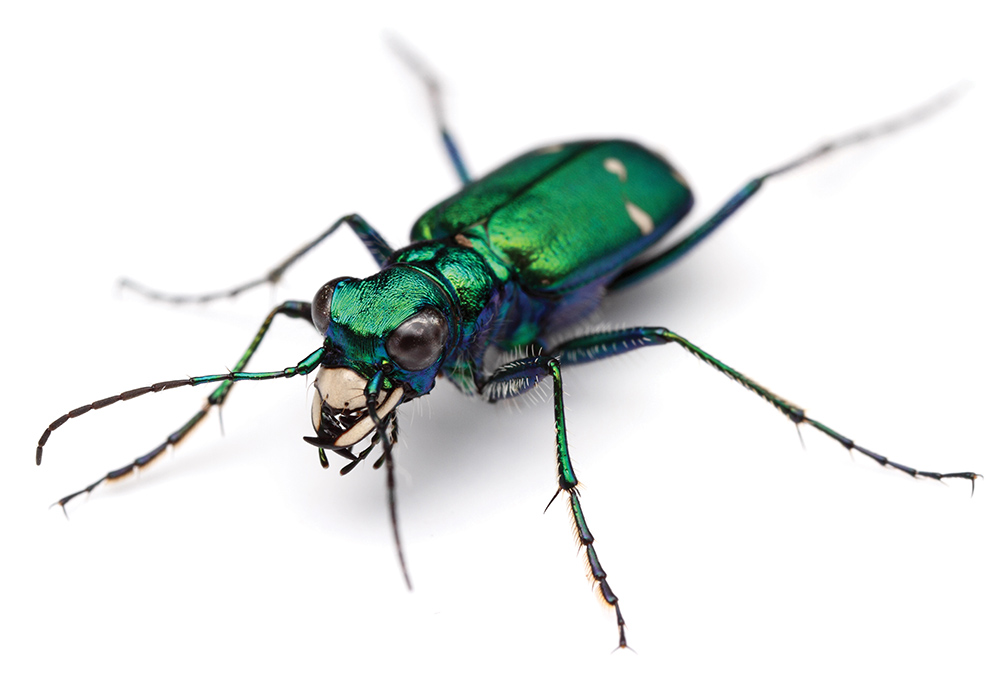
They needed a curator for their entomology collection. Wild was trained as a taxonomist—a biologist who describes, classifies, and names organisms. His skills and reputation as a photographer meant he was in a unique position to raise the profile of the collection and share it with the broader public.
Now Wild is the curator of the second-largest entomology collection in Texas, consisting of more than 2 million specimens from all over the world—from brilliant emerald butterflies to fleas. Bowdoin also makes a couple of appearances in the collection. Wild has added some of the ants he collected when he was an undergraduate. Entomologists frequently collect multiple individuals and distribute some of their specimens to other collections. One drawer of the collection holds a tiny Myrmica incompleta ant he collected on Kent Island on his birthday.
Gall wasps are another Bowdoin connection. Another box in the collection contains minuscule wasps collected in Mexico in the 1930s by Alfred Kinsey, Class of 1916. Kinsey is most famous for his research on human sexuality, but he started his career in biology studying these tiny insects that inject their eggs into plants (typically oaks), causing deformities we call galls. Kinsey collected more than 7 million of these wasps, some of which ended up in the University of Texas’s collection via one of his graduate students, Osmund Breland, who became a professor there.
Most of the insects in the collection are dried, mounted on pins, and stored in drawers. But many specimens that have not been identified yet are stored in vials of ethanol in a separate room. “This room has the most valuable stuff in the whole collection, as far as I’m concerned. If the building starts burning down, this is the room we run to and grab stuff, even though it’s the most flammable,” laughs Wild. Many of the insects in these vials were collected decades ago, but no one has had the time to identify and pin them yet—a case of too many insects and not enough entomologists.
There are vials of insects collected in the Galapagos in the 1970s before collecting was outlawed there for conservation reasons. Another group of vials contains insects collected decades ago in Central America as part of a study on bird diets. These specimens have not been sorted or identified yet. Wild selects a vial: “I’m looking at these things here. And who knows what that is?” The collection contains some specimens likely unknown to science.
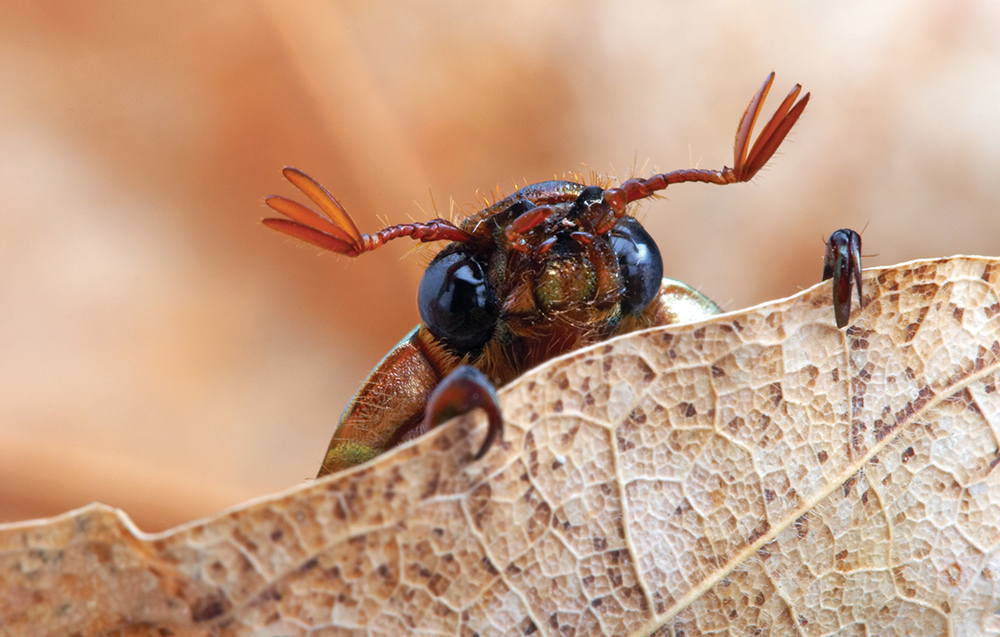
“There are certainly undescribed species on this shelf,” says Wild. “I mean, I’ve discovered two new species of ants just out here at BFL [the University of Texas’s Brackenridge Field Laboratory, in the heart of Austin] since I’ve been here.”
New species of insects are actually more commonly discovered in entomology collections than out in the field. Often, they are specimens that were collected many years earlier, and it took a long time for a taxonomist to get around to identifying them. Scientists estimate there are around 5.5 million species of insects, of which only about 1 million have been collected and scientifically described. According to Wild, this is one of the reasons we need scientific collections. “It takes a lot of time to learn how to tell these things apart. And there aren’t very many people working on them,” he says.
In the fall of 2018, The New York Times ran a feature article with the headline “The Insect Apocalypse Is Here.” The article covered recent long-term studies showing serious declines in insect abundance in some places and discussed the hypothesis that climate change, land use changes, and other human activities could lead to the extinction of insects as a whole. Similar ominous articles appeared in other popular publications.
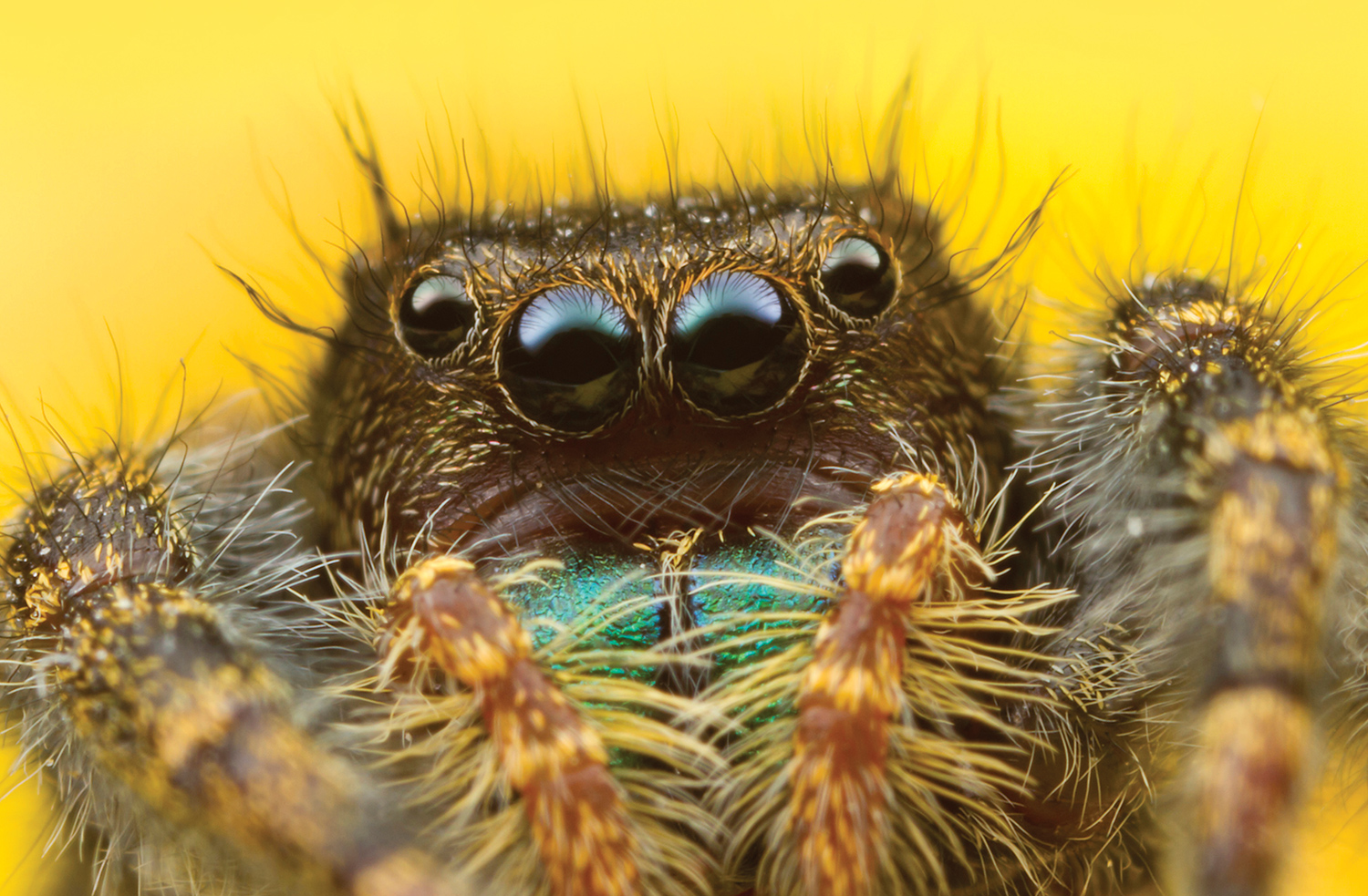
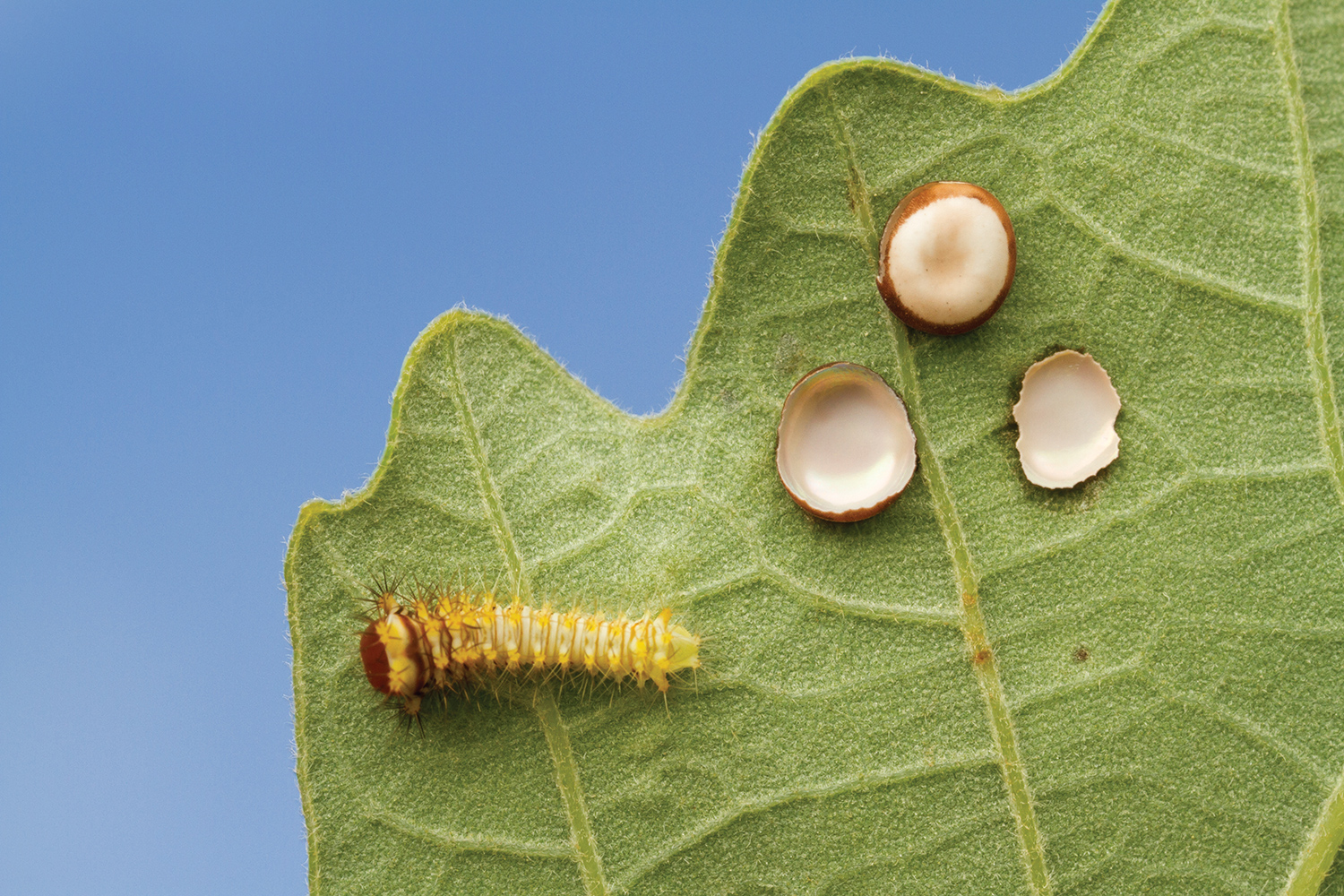
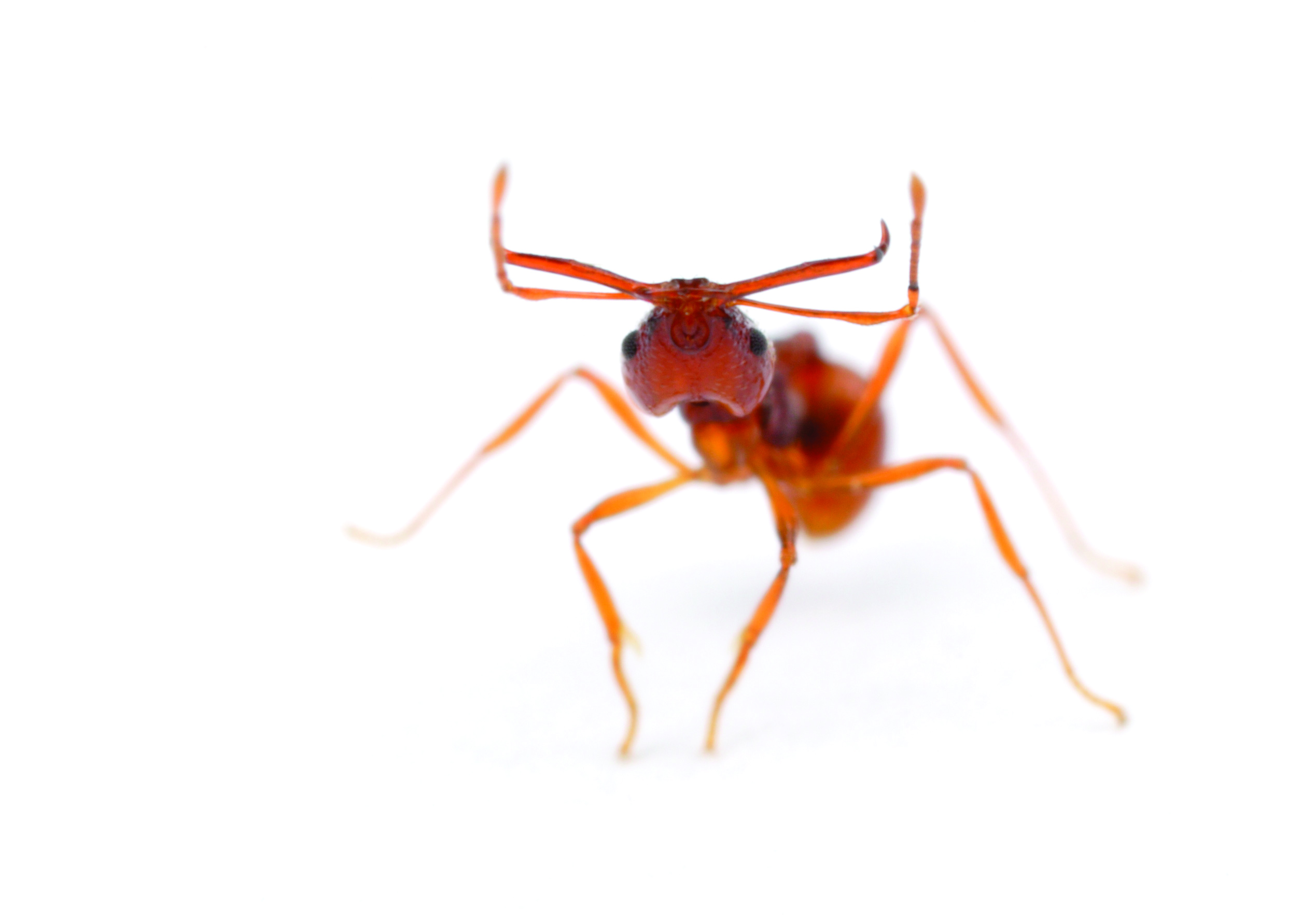
Wild thinks many of these headlines are over-blown. Given the sheer number and diversity of insect species, he says the likelihood of all insect species going extinct is incredibly slim. Some species may be hurt by changes in the environment, but others may benefit. Wild agrees that overall global insect decline is deeply concerning. Given insects’ role as pollinators, recyclers of organic materials (i.e., carrion beetles), and as food for birds and many other animals, declines in insect abundance could have cascading effects through ecosystems. He points out that we only have good abundance data for a handful of economically or medically important groups, like honey bees or mosquitos. We need more information about insects to figure out how their populations are changing and what we should do about it.
Entomology collections like the one Wild curates are critical to our understanding of insects. “This is foundational infrastructure for biology,” says Wild. “These specimens are how we know what species are, and where they live.” Scientific collections also record diversity, both among and within species. “Species are highly variable,” explains Wild.
“Like our own species—we come in all sorts of shapes, sizes, heights, and colors. Other species are like that as well, but you don’t realize that until you look across the full diversity of the group. We hold what looks like a lot of duplicated material. But really, variation and diversity is what a lot of biology is about.”
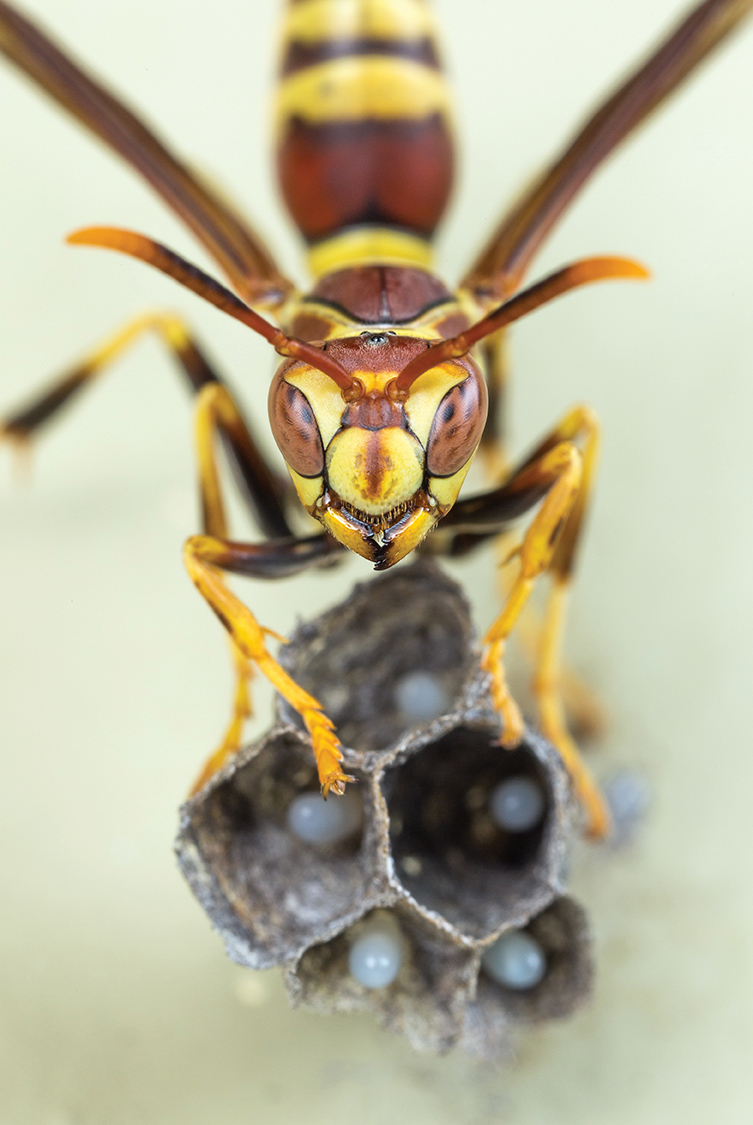
Collections of millions of dead insects may seem old-fashioned. In the age of DNA sequencing and detailed digital imaging, what is the value of having a physical specimen? Would it be more efficient to just sequence a specimen’s DNA, take detailed photographs, and store all this information in an online database?
It’s not that simple. “Unless you can photograph every aspect of [a specimen], you might not catch the bit that you need to see; a lot of insects are identifiable only based on genitalia, for instance,” explains Wild. The specimen is the primary material, and it is important to preserve it. Wild likens it to a Gutenberg Bible in a library: “Yeah, you can scan in that first-edition Gutenberg Bible and throw the Bible away, but how are you going to get the information about what the paper’s made out of and how the press worked? There’s a lot of value in having that.”
Yet, photography is allowing Wild to make the University of Texas’s entomology collection more accessible to the public. Soon after he started as a curator, he started the Insects Unlocked program. Wild and others photograph insects in the collection, and sometimes in the field, and make these photos available as public domain images on the program’s Flickr stream.
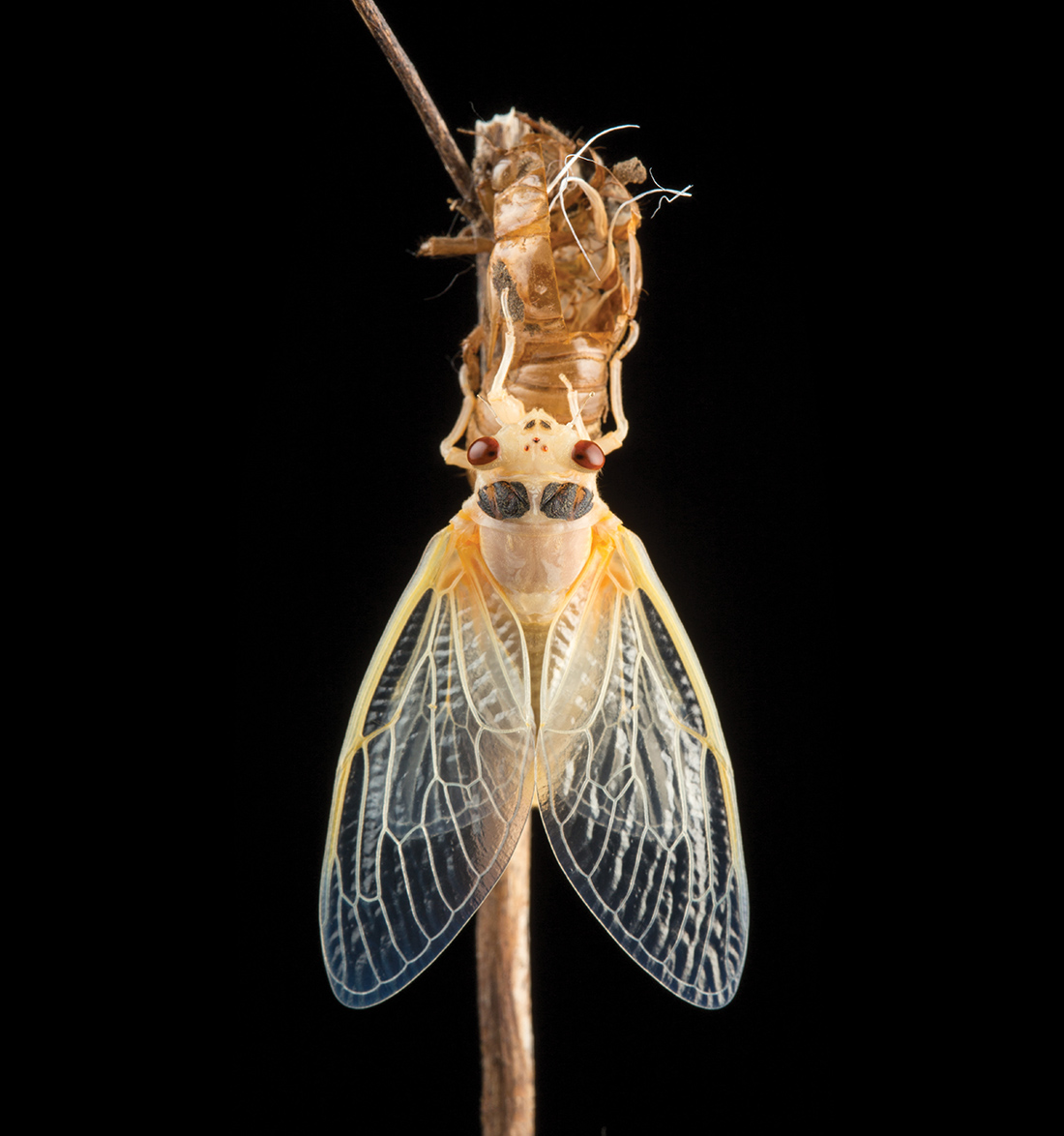
Many of these images are “focus stacked”—a digital image processing technique that allows for incredible detail and depth of field.
No camera lens can produce a crisply focused image overextended depth of field. In a standard photograph, one plane is in focus while the background and foreground are blurred. But focus-stacking software creates a composite image consisting of many digital photos each focused on a different distance—this provides sharp focus through a greater depth of field. The technique is especially useful with insect specimens because it reveals more details, making the photos better references for identification.
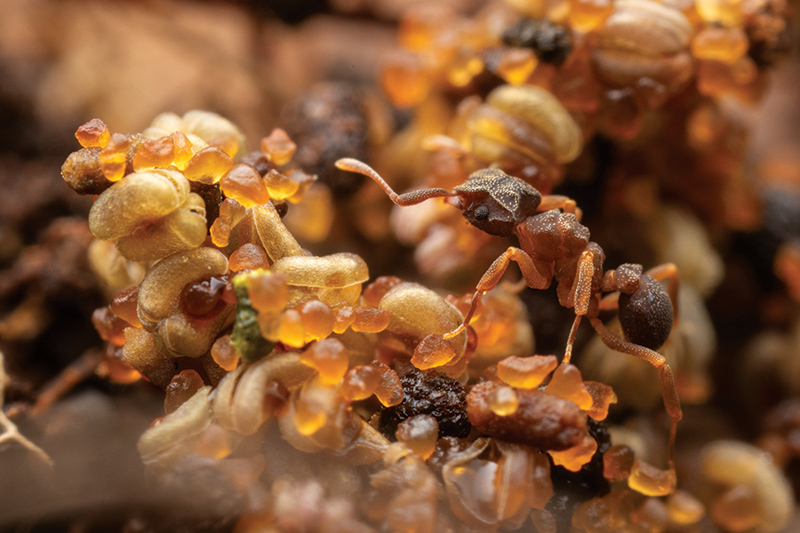
Meredith Swett Walker ’99 is a biologist-turned- science-writer living in western Colorado with her family and a small animal menagerie. She works on communications for the Institute for Bird Populations and enjoys time outdoors with her kids, looking for birds, insects, and all manner of critters.
To see more of Alex Wild ’95's photographs and to purchase prints, go to alexanderwild.com.
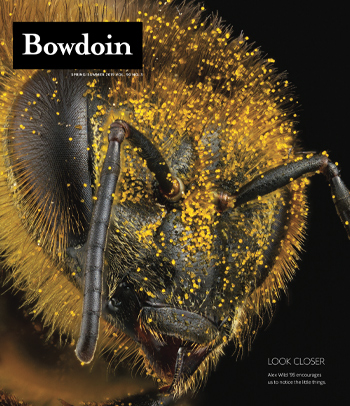
This story first appeared in the Spring 2019 issue of the Bowdoin Magazine. Manage your subscription and see other stories here.